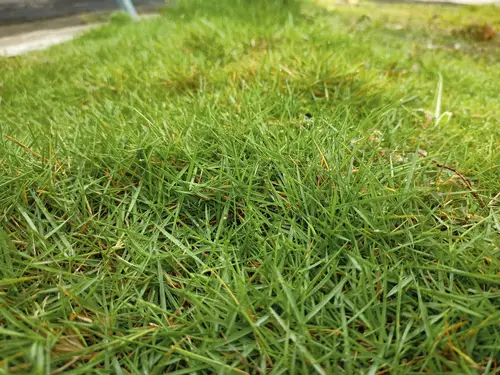Zoysia grass is a popular warm-season grass that is known for its durability and low maintenance requirements. However, it is not uncommon for zoysia turning brown, causing concern among homeowners.
Understanding the reasons behind the browning of zoysia grass can help homeowners take appropriate measures to revive their lawns and maintain their lush green appearance.
There are several common reasons why zoysia grass turns brown. These include pests and diseases, weather conditions, soil and pH levels, watering and irrigation, fertilization, and maintenance practices.
While some of these factors are beyond the control of homeowners, others can be managed with proper care and attention. By identifying the underlying cause of the browning, homeowners can take the necessary steps to restore their zoysia lawns to their former glory.
Key Takeaways
- Zoysia grass can turn brown due to various factors such as pests, diseases, weather conditions, soil and pH levels, watering and irrigation, fertilization, and maintenance practices.
- Homeowners can take appropriate measures to revive their lawns and maintain their lush green appearance by identifying the underlying cause of the browning.
- Proper care and attention can help homeowners manage the factors that are within their control and restore their zoysia lawns to their former glory.
More on this category:
Understanding Zoysia Grass
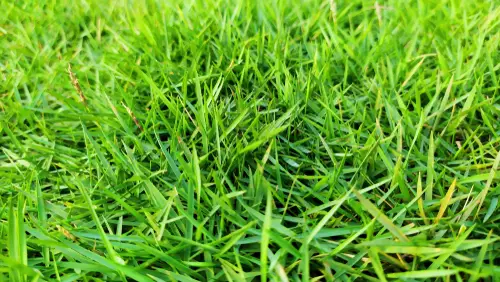
Zoysia grass is a warm-season grass that is known for its dense growth and ability to withstand drought and heavy foot traffic. It is commonly used for lawns, golf courses, and athletic fields. Zoysia grass is native to Asia, but it has been widely cultivated in the United States since the 1950s.
One of the reasons why zoysia grass is so popular is because of its slow growth. This means that it requires less mowing and maintenance than other types of grass.
Zoysia grass also has a deep root system, which allows it to access water and nutrients from deeper in the soil. This makes it more drought-resistant than other types of grass.
Zoysia grass is typically grown from plugs or sod. Zoysia farms are dedicated to cultivating high-quality zoysia sod that is ready for installation in residential and commercial properties. Zoysia sod is a popular choice for homeowners who want an attractive and low-maintenance lawn.
While zoysia grass is known for its durability and low-maintenance requirements, it is not immune to problems. One common issue is the grass turning brown.
There are several reasons why zoysia grass may turn brown, including dormancy, chinch bugs, brown patch, and winter kill. However, with proper management and treatment, the grass can recover and regain its lush green color.
Zoysia Turning Brown – 6 Common Problems
Zoysia is a warm-season grass that is known for its drought tolerance and ability to thrive in hot and humid conditions. However, even healthy zoysia lawns can turn brown for a variety of reasons. Here are some of the most common causes of zoysia turning brown:
1. Cold-Weather Dormancy
Zoysia goes dormant in the winter months and turns brown as a normal response to cooler temperatures. If your entire lawn turns brown in mid-fall, this is likely due to dormancy. You may notice some parts of your lawn going dormant before others.
2. Pests

Grubs, moles, and voles are common pests that can attack the roots of zoysia grass and prevent it from getting the nutrients it needs to survive. If you suspect a pest infestation, turn over a small portion of your lawn to check for grubs.
3. Fungal Diseases
Brown patch, brown spot, and leaf spot are all common fungal diseases that can cause zoysia grass to turn brown. These diseases can be identified by the presence of brown patches or spots on the grass blades. Fungicides can be used to treat these diseases.
4. Overwatering
Overwatering can cause the roots of zoysia grass to rot, which can lead to browning. Make sure you are watering your lawn deeply but infrequently to avoid overwatering.
5. Underwatering
On the other hand, underwatering can also cause zoysia grass to turn brown. Make sure you are watering your lawn enough to keep the soil moist but not waterlogged.
6. Nutrient Deficiencies
Zoysia grass needs a balanced supply of nutrients to thrive. If your lawn is turning brown, it may be due to a nutrient deficiency. A soil test can help you determine which nutrients your lawn is lacking.
Impact of Weather Conditions
Zoysia grass is a warm-season grass that thrives in hot and humid weather conditions. It is drought-tolerant and can withstand long periods of dry weather. However, extreme weather conditions can cause zoysia grass to turn brown and go dormant.
During the winter months, zoysia grass goes dormant and turns brown as a normal response to cold weather. The grass will remain brown until spring when temperatures rise and the grass begins to grow again. If the grass turns brown in mid-fall, it is likely due to cold-weather dormancy and not a cause for concern.
In the transition zone, where temperatures can fluctuate between hot and cold, zoysia grass may experience winter kill. Winter kill occurs when the grass is unable to survive the extreme cold weather conditions. Proper care and maintenance, such as aerating the soil, can help prevent winter kill and ensure the grass remains healthy.
In drought conditions, zoysia grass may also turn brown and go dormant to conserve water. The grass will remain dormant until it receives adequate water and temperatures rise. Zoysia grass is drought-tolerant but still requires regular watering to remain healthy.
Role of Watering and Irrigation

Zoysia grass is drought-resistant, but it still requires proper watering and irrigation to thrive. The right amount of water is essential to the health and appearance of a zoysia lawn. Too little and the grass turns brown, while too much leads to pest and disease problems.
An established zoysia lawn needs between a half inch and one inch of water per week during the growing season. This total includes irrigation and rainfall combined.
It is important to note that overwatering can lead to shallow root growth, which makes the grass more susceptible to drought stress. Therefore, it is necessary to water deeply and infrequently to encourage deep root growth.
To ensure proper watering, it is recommended to use an irrigation system that provides consistent and even coverage. A properly designed and maintained irrigation system can help conserve water and save money on water bills. It is also important to monitor the moisture level of the soil regularly to avoid over or under watering.
In case of drought conditions, zoysia grass can survive for long periods without water. However, it is essential to water the lawn during extended drought periods to prevent the grass from going dormant or dying. During droughts, it is recommended to water the lawn deeply and less frequently to encourage deep root growth.
Pests and Diseases Affecting Zoysia
Zoysia grass is a popular choice for lawns and golf courses because of its durability and ability to tolerate heat and drought. However, like any other grass, zoysia can be susceptible to pests and diseases that can cause it to turn brown and die.
Pests
Chinch bugs and grubs are two common pests that can affect zoysia grass. Chinch bugs are small insects that feed on the sap of the grass blades, causing them to turn yellow and eventually brown. Grubs are the larvae of beetles that feed on the roots of the grass, causing it to become weak and die.
While these pests can cause significant damage to zoysia grass, there are also beneficial insects that can help control their populations. Ladybugs, lacewings, and parasitic wasps are just a few examples of insects that can help keep chinch bug and grub populations in check.
Diseases
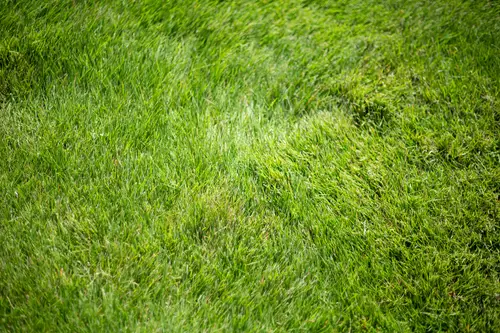
Zoysia grass can also be susceptible to various diseases that can cause it to turn brown and die. Brown patch is one of the most common diseases that affect zoysia grass. It is characterized by circular patches of brown grass surrounded by a ring of dark green grass.
Rust is another disease that can affect zoysia grass. It is characterized by orange or yellow spots on the grass blades that eventually turn brown and cause the grass to die.
While pesticides and insecticides can be effective in controlling pests and diseases, they can also harm beneficial insects and other organisms that are important for the health of the ecosystem.
Insecticidal soap is a safer alternative to traditional pesticides and insecticides that can help control pest populations without harming beneficial insects.
Importance of Soil and pH
Zoysia grass is known for its tolerance to heat, drought and traffic, making it a popular choice for lawns and sports fields. However, when the grass starts to turn brown, it can be a sign of an underlying problem that needs to be addressed.
One important factor that affects the health of zoysia grass is the quality of the soil it is growing in, and the pH level of that soil.
Soil Quality
Zoysia grass prefers well-drained soil that is rich in nutrients. Soil that is too compacted can prevent water and nutrients from reaching the roots, leading to brown spots and thinning of the grass.
Clay soil is common in many areas, and while it can be fertile, it can also be dense and poorly drained. To improve the soil quality, it is recommended to aerate the soil and add organic matter, such as compost or peat moss. This will help to loosen the soil and improve drainage, while also providing essential nutrients to the grass.
pH Level
The pH level of the soil is another important factor that affects the health of zoysia grass. The ideal pH level for zoysia grass is between 6 and 7. If the pH level is too low, the grass may turn yellow and struggle to grow. If the pH level is too high, the grass may turn brown and become more susceptible to disease.
To determine the pH level of the soil, a soil test can be performed. If the pH level is too low, lime can be added to raise the pH level. If the pH level is too high, sulfur can be added to lower the pH level.
Fertilization and Its Effects

Fertilizing your zoysia lawn can be an effective way to keep it healthy and green. However, over-fertilization can lead to brown patches and other problems. It is important to understand the effects of fertilization on your lawn and to use the right type and amount of fertilizer.
1. Fertilizer Types
There are many types of fertilizers available, including synthetic and natural options. Synthetic fertilizers are often cheaper and provide quick results, but they can also be harmful to the environment and may cause long-term damage to your lawn.
Natural lawn fertilizers, on the other hand, are made from organic materials and are safer for the environment. They may take longer to show results, but they can provide long-term benefits to your lawn.
2. Over-Fertilization
Over-fertilization is a common problem that can cause your zoysia lawn to turn brown. When you apply too much fertilizer, it can burn the grass and cause it to dry out. This can lead to brown patches and other problems. It is important to follow the instructions on the fertilizer package and to use the right amount for your lawn.
3. Natural Lawn Fertilizer
Using a natural lawn fertilizer can be a good way to avoid over-fertilization and keep your zoysia lawn healthy. These fertilizers are made from organic materials and provide a slow-release of nutrients to your lawn. This can help to prevent brown patches and other problems while also promoting healthy growth.
4. Fertilizing Schedule
It is important to fertilize your zoysia lawn at the right time and with the right amount of fertilizer. This will depend on the type of fertilizer you are using and the specific needs of your lawn. In general, it is best to fertilize in the spring and fall when the grass is actively growing.
You should also avoid fertilizing during hot, dry weather as this can lead to over-fertilization and other problems.
Maintenance and Lawn Care
To keep a Zoysia lawn healthy and green, proper maintenance and lawn care are essential. Regular mowing, aeration, dethatching, and topdressing can help prevent brown patches and promote healthy growth.
1. Mowing

Mowing is an important part of lawn care. Zoysia grass should be mowed regularly, but not too short. A good rule of thumb is to keep the grass at a height of 1-2 inches. Mowing too short can damage the grass and cause it to turn brown.
2. Aeration
Aeration is the process of creating small holes in the soil to allow air, water, and nutrients to penetrate the roots. This helps the roots grow deeper and stronger, which can prevent brown patches and promote healthy growth. Aeration should be done once a year in the spring or fall.
3. Thatch
Thatch is a layer of dead grass and other organic material that accumulates on the surface of the soil. Too much thatch can prevent air, water, and nutrients from reaching the roots, which can cause the grass to turn brown.
Dethatching is the process of removing the thatch buildup from the lawn. This should be done once a year in the spring or fall.
4. Topdressing
Topdressing is the process of adding a thin layer of soil or compost to the surface of the lawn. This can help improve soil quality, promote healthy growth, and prevent brown patches. Topdressing should be done once a year in the spring or fall.
Dealing with Shade and Tree Coverage
Zoysia grass requires a lot of sunlight to thrive, and if it is not getting enough, it can turn brown or even die. If you have trees in your yard, they may be causing too much shade for your Zoysia grass. In this case, it is recommended to trim the lower branches of the trees to allow more sunlight to reach the grass.
Another factor to consider is the orientation of your lawn. If your Zoysia grass is on the north side of your house, it may not be getting enough sunlight, and this can cause it to turn brown.
In contrast, if it is on the south side, it may be getting too much sunlight, which can also cause it to turn brown. In this case, it is recommended to plant more shade-tolerant grasses on the north side of your house and more sun-tolerant grasses on the south side.
If you cannot trim the lower branches of the trees, you can also consider planting shade-tolerant plants or groundcovers around the trees to help absorb some of the excess moisture and nutrients that can cause Zoysia grass to turn brown. Some good options include hostas, ferns, and ivy.
It is also important to note that Zoysia grass is extremely sensitive to over-watering and over-fertilizing, so be sure to avoid these practices if you have trees or too much shade in your yard. Instead, water your Zoysia grass deeply but infrequently, and use a slow-release fertilizer to avoid burning the grass.
Managing Zoysia in Different Regions
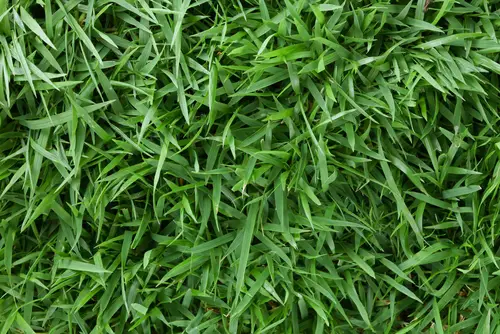
Zoysia is a warm-season grass that thrives in hot and humid regions. However, it can also grow in cooler regions with proper care and maintenance. In this section, we will discuss how to manage zoysia in different regions.
Warm Regions
Zoysia is well-suited for warm regions with long summers and mild winters. In these regions, zoysia can grow vigorously and provide a lush green lawn. However, warm regions also have high humidity and rainfall, which can lead to fungal diseases such as brown patch.
To manage zoysia in warm regions, it is essential to follow these tips:
- Mow the lawn regularly to maintain a height of 1-2 inches.
- Water the lawn deeply once a week, rather than frequent shallow watering.
- Fertilize the lawn in spring and summer with a slow-release fertilizer.
- Control pests such as chinch bugs and grubs, which can damage the roots of zoysia.
Cooler Regions
Zoysia can also grow in cooler regions, but it requires more care and maintenance. In these regions, zoysia may go dormant during the winter and turn brown. However, it will green up again in the spring.
To manage zoysia in cooler regions, it is essential to follow these tips:
- Choose a cold-tolerant variety of zoysia such as ‘Meyer’ or ‘Zenith’.
- Plant zoysia in a sunny area with good drainage.
- Water the lawn deeply once a week during the growing season.
- Fertilize the lawn in spring and summer with a slow-release fertilizer.
- Cover the lawn with a winter blanket or straw during the winter to protect it from frost.
Treatment and Control Measures
When zoysia grass turns brown, it is important to take immediate action to prevent further damage. Here are some treatment and control measures that can help restore the health of your zoysia lawn:
1. Soil Testing and Amendments
One of the first steps in treating brown zoysia grass is to test the soil pH levels. If the pH is below 6, adding lime can help raise the pH. If the pH is above 7, adding sulfur can help lower it. By ensuring that the soil pH is within the optimal range of 6 to 7, you can help your zoysia grass to absorb the necessary nutrients for growth.
2. Fungicides

If the cause of the brown zoysia grass is a fungal infection, applying fungicides can be an effective treatment. Fungicides can help control and prevent the spread of diseases such as brown patch, dollar spot, and leaf spot.
However, it is important to note that fungicides should only be used as a last resort and should be applied according to the manufacturer’s instructions.
3. Repair and Reseeding
If the brown zoysia grass is caused by damage or wear and tear, repairing the damaged areas and reseeding can help restore the lawn’s health. This involves removing the dead grass, loosening the soil, and adding new grass seed.
Watering the area regularly and keeping it well-maintained can help the new grass seed to grow and blend in with the existing lawn.
4. Pest Control
Pests such as grubs, moles, and voles can also cause brown zoysia grass by attacking the roots and preventing the grass from absorbing nutrients. Using pest control measures such as insecticides and traps can help control the pest population and prevent further damage to the lawn.
5. Proper Lawn Care
Finally, proper lawn care is essential for preventing and treating brown zoysia grass. This includes regular mowing, watering, and fertilizing according to the specific needs of zoysia grass. Avoid over-fertilizing or over-watering, as this can lead to fungal infections and other issues.
By following these treatment and control measures, homeowners can help restore the health of their zoysia lawn and prevent further damage.
Reviving Brown Zoysia
When Zoysia grass turns brown, it is not necessarily dead. There are several things that can be done to revive it and help it thrive again. Here are some tips for reviving brown Zoysia:
1. Determine the Cause
The first step to reviving brown Zoysia is to determine the cause of the problem. This can be done by examining the grass and looking for signs of pests, disease, or other issues. It is also important to consider factors such as weather conditions, watering practices, and soil quality.
2. Address the Underlying Issue
Once the cause of the problem has been identified, it is important to address the underlying issue. For example, if the grass is turning brown due to a lack of water, it may be necessary to adjust the watering schedule or install a sprinkler system. If the problem is due to pests or disease, appropriate treatments should be applied.
3. Promote Healthy Growth
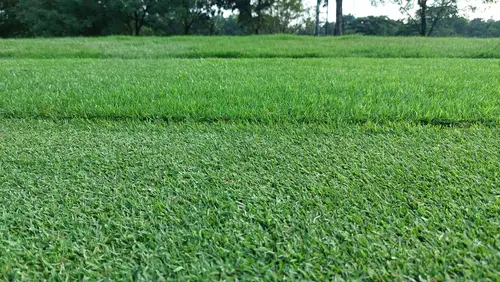
To promote healthy growth and help the Zoysia grass thrive, it is important to provide it with the nutrients it needs. This can be done by applying a high-quality fertilizer that is specifically designed for Zoysia grass.
It is also important to ensure that the grass has a healthy root system, which can be achieved by aerating the soil and using plugs to fill in bare spots.
4. Proper Lawn Management
Proper lawn management is also important for reviving brown Zoysia. This includes regular mowing, which should be done at the appropriate height for Zoysia grass. It is also important to avoid overwatering, as this can lead to root rot and other issues.
By following these tips, it is possible to revive brown Zoysia and help it become green and healthy once again. With proper care and maintenance, Zoysia grass can thrive and provide a beautiful lawn for years to come.
Understanding Zoysia’s Growth Pattern
Zoysia is a warm-season grass that has a unique growth pattern. It grows more slowly than other grasses, but it also requires less maintenance, making it a popular choice for lawns. Zoysia grass grows in a pattern that is different from other grasses, and understanding this pattern is important for maintaining a healthy lawn.
Zoysia grass has a dense growth pattern that creates a thick, lush lawn. It grows horizontally through the soil, producing a thick mat of roots and stems. This growth pattern allows Zoysia to withstand heavy foot traffic, making it an ideal choice for high-traffic areas.
Zoysia grass is also known for being relatively maintenance-free. It requires less mowing than other grasses, and it is also more drought-tolerant. However, it is important to note that Zoysia grass does require some maintenance, such as regular watering and fertilization, to maintain its health.
In terms of growth, Zoysia grass grows best in warm temperatures, and it can take several weeks for it to establish itself. Once established, Zoysia grass can grow up to 2 inches per week during the growing season. However, it is important to note that Zoysia grass will go dormant in the winter months, turning brown until the spring.
Zoysia’s Resistance and Tolerance
Zoysia is a warm-season grass that is known for its excellent resistance and tolerance to various environmental stressors. Its ability to withstand drought, extreme temperatures, and heavy foot traffic makes it a popular choice for lawns and sports fields.
One of the main reasons for Zoysia’s resistance to drought is its deep root system, which allows it to access water from deeper soil layers. This, in turn, enables the grass to survive long periods of dry weather without showing signs of stress.
Zoysia also has a unique ability to go dormant during periods of extreme drought, which helps it conserve water and energy until conditions improve.
In addition to drought tolerance, Zoysia is also known for its ability to withstand extreme temperatures. This grass can survive in a wide range of climates, from hot and humid to cold and dry. Some varieties of Zoysia are even able to tolerate temperatures as low as -30°F.
Another factor that contributes to Zoysia’s resilience is its ability to recover quickly from damage. This grass has a robust growth habit, which allows it to quickly fill in bare spots and repair damage caused by foot traffic or other stressors.
Frequently Asked Questions
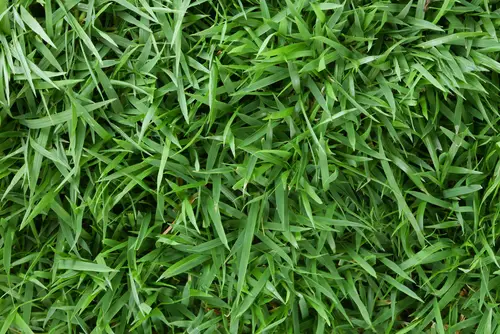
Why is my Zoysia grass turning brown?
Zoysia grass can turn brown due to several reasons, including cold-weather dormancy, drought stress, fungal diseases, and insect infestations.
Cold-weather dormancy is a natural response to cooler temperatures, and the grass will turn brown in mid-fall. If the grass turns brown during the growing season, it may be due to drought stress, which can be remedied by watering the grass deeply and less frequently.
Fungal diseases, such as brown spot, can also cause the grass to turn brown. Insect infestations, such as chinch bugs, can damage the grass and cause it to turn brown.
How to fix brown spots in Zoysia grass?
To fix brown spots in Zoysia grass, the first step is to identify the cause of the problem. If the brown spots are due to drought stress, watering the grass deeply and less frequently can help.
If the brown spots are due to fungal diseases, applying a fungicide can help. If the brown spots are due to insect infestations, applying an insecticide can help. In severe cases, it may be necessary to remove and replace the affected areas of the grass.
How to revive dead Zoysia grass?
Reviving dead Zoysia grass can be challenging, but it is possible with proper care and maintenance. The first step is to remove any dead grass and debris from the area. Then, aerate the soil to improve drainage and oxygenation.
Next, apply a high-nitrogen fertilizer to promote new growth. Water the grass deeply and less frequently to prevent drought stress. In some cases, it may be necessary to overseed the area with new Zoysia grass seed.
How do I bring Zoysia grass back to life?
To bring Zoysia grass back to life, the first step is to identify the cause of the problem. If the grass is dead due to drought stress, watering the grass deeply and less frequently can help.
If the grass is dead due to fungal diseases, applying a fungicide can help. If the grass is dead due to insect infestations, applying an insecticide can help. In severe cases, it may be necessary to remove and replace the affected areas of the grass.
Will dead Zoysia grass come back?
Dead Zoysia grass may come back if the roots are still alive. However, it is important to identify the cause of the problem and address it before attempting to revive the grass.
If the grass is dead due to drought stress, fungal diseases, or insect infestations, it may be necessary to remove and replace the affected areas of the grass.
Why does Zoysia turn brown in winter?
Zoysia grass turns brown in winter due to cold-weather dormancy. Zoysia is a warm-season grass that goes dormant as soon as cooler temperatures set in.
The grass will turn brown in mid-fall as a normal response to quit active growth during the winter. Some parts of the lawn may go dormant before others, and the grass will return to its green color in the spring when temperatures warm up again.

Hey, I’m Lisa and I’ve been an avid gardener for over 30 years. I love writing, talking and living in the garden! Feel free to connect with me on my socials below

